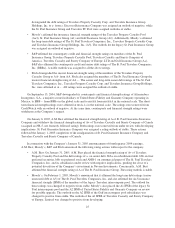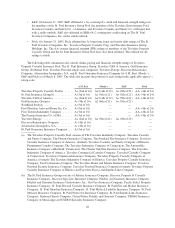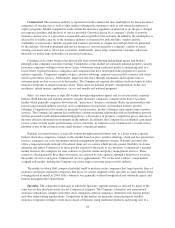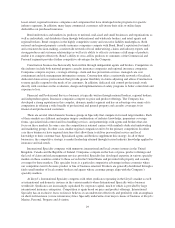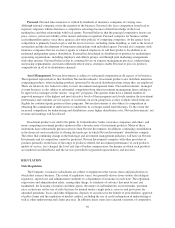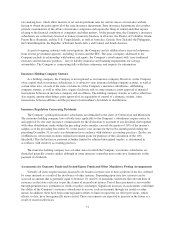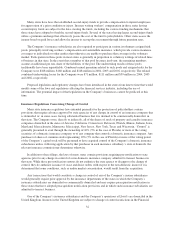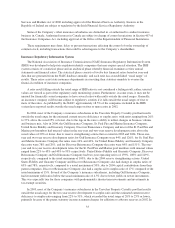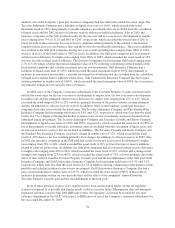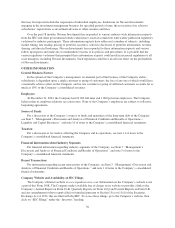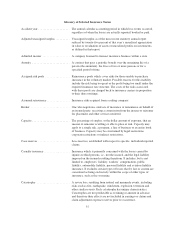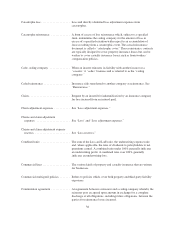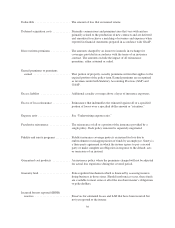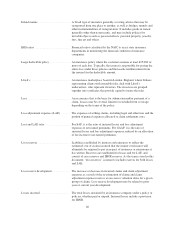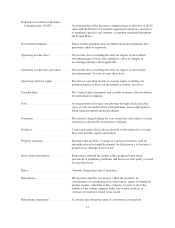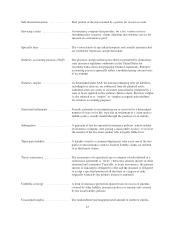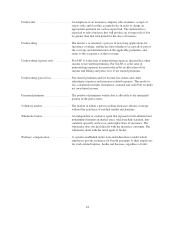Travelers 2004 Annual Report Download - page 46
Download and view the complete annual report
Please find page 46 of the 2004 Travelers annual report below. You can navigate through the pages in the report by either clicking on the pages listed below, or by using the keyword search tool below to find specific information within the annual report.addition, one of the Company’s principal insurance companies had one other ratio outside the usual range. The
Travelers Indemnity Company had a liabilities to liquid assets ratio of 116%, which exceeded the usual
maximum result of 105% due primarily to sizable subsidiary investments that are excluded from the calculation
of liquid assets and the 2002 increase in asbestos reserves that are included in liabilities. Also in 2003, the
insurance companies in the Gulf pool had results for the one-year and two-year reserve development to surplus
ratios ranging from 75% to 112% and 88% to 120%, respectively, which exceeded the usual result of 20% or
lower for both of these measures because of reserve additions related primarily to the residual value business
coupled with increases in core business lines and the reserve for uncollectible reinsurance. The reserve additions
also resulted in the Gulf pool companies having two-year overall operating ratios ranging from 128% to 134%
which is in excess of the usual value of 100% or lower. In addition, the Gulf pool companies had an estimated
current reserve deficiency to surplus ratio ranging from 163% to 268% which exceeded the usual result of 25%
or lower also due to these reserve additions. The Gulf pool companies had investment yield ratios ranging from
2.7% to 3.4% which is below the normal minimum value of 4.5% reflecting a shortening of the duration of the
fixed maturity portfolio and a decline in interest rates on new investments. Gulf Insurance Company had a
liabilities to liquid assets ratio of 115% which exceeded the usual maximum result of 105% due primarily to
increases in reinsurance recoverables, a sizeable investment in subsidiaries that are excluded from the calculation
of liquid assets and the reserve additions noted above. Gulf Underwriters Insurance Company also had a gross
written premiums to surplus ratio of 1065%, which exceeded the usual maximum value of 900% due to increases
in premiums written on core specialty lines of business.
In 2002, most of the Company’s insurance subsidiaries in the Travelers Property Casualty pool had results
outside the usual range for the one year reserve development to surplus ratio, the two year reserve development
to surplus ratio and the estimated current reserve deficiency to surplus ratio ranging from 21% to 44%, which
exceeded the usual range of 20% to 25% or lower, primarily because of the pretax statutory income statement
charges for additions to asbestos reserves in 2002. In addition, three of the Company’s principal insurance
companies had other ratios outside the usual range. The Travelers Indemnity Company and The Standard Fire
Insurance Company had investment yield ratios of 3.8% and 4.2%, respectively, which were less than the usual
results of 4.5% or higher, reflecting the decline in interest rates on new investments and lower dividends from
subsidiary equity investments. The Travelers Indemnity Company and Travelers Casualty and Surety Company
had liabilities to liquid assets ratios of 120% and 107%, respectively, which exceeded the usual result of 105% or
lower due primarily to sizable subsidiary investments that are excluded from the calculation of liquid assets and
an increase in asbestos reserves that are included in liabilities. The Travelers Casualty and Surety Company and
the Standard Fire Insurance Company each had a change in surplus ratio of -12%, which exceeded the usual
result of -10% due to a net loss resulting primarily from charges for additions to asbestos reserves in 2002. Also
in 2002, the insurance companies in the Gulf pool had results for the two year reserve development to surplus
ratio ranging from 32% to 44%, which exceeded the usual result of 20% or lower because of reserve additions
related to a run-off product line. In addition, the Gulf pool companies had an estimated current reserve deficiency
to surplus ratio ranging from 46% to 84%, which exceeded the usual result of 25% or lower and a change in net
writings ratio ranging from 223% to 403%, which exceeded the usual result of 33% or lower primarily due to the
effect of their removal from the Travelers Property Casualty pool and the reestablishment of the Gulf pool. Gulf
Insurance Company and Gulf Underwriters Insurance Company had investment yield ratios of 4.3% and 3.9%,
respectively, which were less than the usual result of 4.5% or higher reflecting a shortening of the duration of the
portfolio and a decline in interest rates on new investments. Gulf Underwriters Insurance Company also had a
gross written premiums to surplus ratio of 1235%, which exceeded the usual result of 900% or lower due to
increases in premiums written on core specialty lines and the effect of the companies’ removal from the
Travelers Property Casualty pool and the reestablishment of the Gulf pool.
In all of these instances in prior years, regulators have been satisfied upon follow-up that no regulatory
action was required. It is possible that similar results could occur in the future. Management does not anticipate
regulatory action as a result of the 2004 IRIS ratio results. No regulatory action has been taken by any state
insurance department or the NAIC with respect to IRIS ratios of any of the Company’s insurance subsidiaries for
the year ended December 31, 2003.
34



